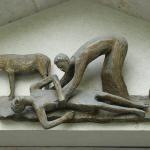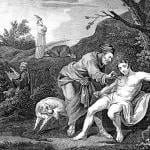A Vox Nova commenter recently asked the following:
What does adherence [to the Magisterium] mean? How much can we criticize? How do we disagree? What should we be compelled to believe? . . . What role does the magisterium have in our lives as Catholics?
I won’t attempt to deal with each of these questions here. In terms of “What should we be compelled to believe,” it has been established that Catholic teaching is comprised of a “hierarchy of truths” which means certain types of teaching are “more central” than others, and less central teachings can often times be debated. Which teachings belong where is precisely what is in question, and these debates are at the root of many of our charitable discussions here at Vox Nova. I can’t rehearse the various viewpoints here, but I will recommend two books on the topic: Magisterium: Teaching Authority in the Catholic Church by Francis Sullivan, S.J. and By What Authority?: A Primer on Scripture, the Magisterium, and the Sense of the Faithful by Richard Gaillardetz. Others might have alternative recommendations for thinking about these issues.
What I do want to offer are my own reflections on the question of criticism of Church teaching and how, if ever, it should be done. In doing so I primarily want to distinguish between two types of dissent: 1) a dissent born from modernity’s general suspicion of tradition, and 2) a prophetic dissent rooted in Christian tradition itself, what Karl Rahner would call the Church’s built-in capacity for self-critique. The first type is obviously not acceptable in Catholic thinking but remains a temptation among many Catholics. It can be especially tempting for new students of Catholic theology who feel liberated by the task of really engaging Church teaching for the first time, as I felt when I decided to switch my major to theology during my undergraduate years. We see this approach to dissent embodied in such questions as “What gives the Church the right to tell me __________?” (fill in the blank, from your own experience).
The second type of dissent is much more rare, and involves an entirely different perspective on ecclesial authority and tradition. Not only is this approach to dissent often acceptable, I will make the claim (with help from Nicholas Healy and Karl Rahner) that this type of dissent can actually be a responsibility of the faithful. I apologize in advance for the length of this post, which is the case for two reasons: first, because I have written on this topic in posts at my own blog in the past and I would like to incorporate some of that material here, and secondly, because I think this distinction is vitally important for discussions like the ones we have at Vox Nova, a blog which explicity claims adherence to the Magisterium. Because the latter is true, it is important that we move beyond simplistic ideas about what this “adherence” means and what it does not mean, and I offer these thoughts for consideration. They are my own, and not meant to be understood as the viewpoint of the other members of Vox Nova or the blog as a whole [1].
About a year ago, a friend of mine (who has since completed a masters in theology from the University of Dayton, and who has become a fairly frequent commenter at VN) posted an insightful piece arguing for “radical assent” to the fullness of the Church’s teaching over against what he calls the “contemporary trend” of dissenting from the Church. Unfortunately, that post was part of an old blog of his which was deleted by his webhosting service, and so I cannot link to the post in its entirety. A couple excerpts are preserved in a post of mine and they give an indication of his main argument that contemporary dissent in the Church is linked to modernity’s suspicion of authority and tradition, its elevation of the individual conscience, and its promotion of capitalism and consumer choice:
The contemporary trend of dissenting from the Church, it must be admitted, is a side-effect of this condition. This does not mean reform understood in its traditional sense, where change occurs through official channels, where the limits of what is reformable are clearly defined (dogma, doctrine, procedure, private theology, etc.), and where the reformers maintain the rightful position of the Church as the ultimate judge of morality. By this we mean, detraction from Church teaching based upon the derision of being “told” what to believe, instead of using “reason” to come a conclusion about a matter as an “individual” (all of which was accepted on faith by the authorities as a community of people, ironically).
I think Adam is right, both in his identification of a clear problem and its causes. This type of dissent is much too common, and for many Catholics seems to be something to be admired and pursued, or a ‘way of life’ [2]. As I suggested earlier, I certainly had my own period of flirtation with this stance.
What I was a bit uncomfortable with was his conclusion and solution, which I said was perhaps a bit overstated:
For these reasons assent to the totality of the Church’s teachings (assuming that they have been received and understood properly) may be viewed as an anti-capitalist, anti-statist, and anti-liberal way of life and form of resistance. Obedience and assent open one to way of life that socialists think drive “class struggle,” that capitalist view as borderline “tyrranical,” that liberals believe is “unreasonable” and “irrational,” and that capitalists find unmarketable. Assent may be the best tool Catholics wishing to resist state power have.
While I agree with Adam’s critique of the “contemporary trend” he identified, I’m not sure I would write off ecclesial dissent as a whole, as I am not sure that all forms of dissent are philosophically rooted in the way that he describes. I would even go so far as to suggest — following Catholic theologians like Nicholas Healy, Terrence Tilley, and Karl Rahner — that dissent sometimes functions as a necessary part of the process of the formation of tradition over time as well as the Church’s self-critique in terms of how it embodies that tradition.
Healy, for example, drawing on Balthasar’s theodramatic theory, writes:
The courage displayed by any good disciple is a contributing factor in the tensive relation between the individual and the church. The theodramatic horizon emphasizes the point that the church is not the kind of collective that demands the individual give herself over to the group; rather, we each are to give ourselves over to Christ in discipleship. It may well happen that for some disciples, participation in the church will involve much more than, say, simply joining in the Sunday service with an attitude of enthusiastic but unreflective conformity. It is true that every disciple must learn humble obedience from the church those practices, beliefs and valuations that enable her to become a better disciple. Yet it may be on occasion that an individual’s contribution to the church’s witness will require her to be a prophetic thorn in its flesh. She may find herself having to challenge certain ecclesial cultural patterns as embodying either hitherto unnoticed anti-Christ or presently unsuitable non-church elements. Her challenge may arise under the influence of non-church or anti-Christ traditions of inquiry, or it may be a prophetic response directly to some aspect of the tradition, or, most likely, it will be a combination of both. Failure to respond to such a call, if it were indeed truly such, would be a failure of discipleship. It would, furthermore, hinder the church’s task of witness by tacitly supporting a falsifying embodiment of it. Naturally, to mount such a challenge is difficult, since it may be misdirected or its motivation misunderstood. But it should not be made more difficult than it need be by an ecclesiastical culture that brooks no dissent or discussion. Such internal challenges are a part of the dramatic struggle that constitutes Christian ecclesial existence, and should not be countered by overly epic and idolatrous claims to mastery of the theodrama. As Balthasar remarks, it is the saints who are the best interpreters of theodrama, for what they know is ‘lived out in dramatic existence.’ One task for ecclesiology is to find a place among the church’s practices for such solitary or minority forms of prophetic discipleship [3].
Healy’s take — which is clearly not a modernist one — would reject dissent as a ‘way of life,’ but would leave open the possibility for dissent based on what we might call intra-traditional sources and reflection.
Or with Rahner, he might say that prophetic self-critique is indeed “built into” the Church itself. For Rahner, this is because the Church is subordinate to Christ: “The Church is not identical with Christ: it is not our goal and fulfillment in the same sense as he is. The body of Christ is distinct from him, receives from him, and serves him” [4]. Christ stands over the Church as judge, but more importantly as forgiver, the mediator of God’s gift of God’s self, and the source of the Church’s holiness. The concrete Church as a social, institutionalized reality in the world, is threatened by the dangers that any institution will face, and so there is and will always be a tension between what the Church seeks to be and what the Church is in the concrete [5]. This tension means that the Church has a process of self-criticism built into itself. The Church is in a state of “permanent revolution” in which “criticism of its own actual performance is an element in its nature” [6].
I think Adam would agree that, to some extent, tradition has changed over time through the reality of ecclesial dissent which has gone through the “proper channels,” resulting in legitimate reform. But what of the fact that some legitimate dissenting positions usually will not have access to the “proper channels?” As was the case with the major insights of Latin American liberation theologians, such dissenting viewpoints are often marginalized — sometimes actively — before they are able to “get a hearing” and move through the “proper channels” to become part of the tradition of the Church. Today, many of those insights, such as the preferential option for the poor, have gone through these channels and have made their way into the Church’s social doctrine. But this certainly didn’t happen overnight, or without opposition by certain sectors of those official channels, and until the “teaching church” learned through the “learning church” so to speak, promoters of these new ideas were considered “dissenters.”
I’m also concerned about the possibility that “radical assent” without an accompanying sense of “thinking (actively) with the Church” can be a form of consumeristic religion in disguise. Consider that an equally problematic tendency of modern and contemporary consumerism is consumption without thought as to the origins of the product consumed, i.e. “I don’t care where the tomatoes on my Taco Bell taco supreme came from; Give me the taco,” or “I don’t care under what conditions my Nike’s were made, or what they are made out of; I love my comfortable Nike’s.” “Radical assent” alone, without reflection, could in fact be just another type of consumption to individual Catholics who are more comfortable existing in the mode of mere passive reception — and smug satisfaction with having accepted the “orthodox” position — instead of a mode of active “thinking with the Church” which necessarily involves tensions and ambiguities. And we also know of countless examples of how this sort of “religious consumption” is often connected to supposed articulations of the “fullness of Catholic teaching” that are not necessarily so (e.g., EWTN, Catholic Answers, etc.). Thus, I am not convinced that “radical assent” alone offers the type of resistance called for.
Adam’s post a year ago was an important one, and he was onto something. I regret that I cannot incorporate the response he made to me in yet another post, but that post has been lost. But he has recently revisited the topic at his new blog, incorporating his thoughts on how political anarchism has helped him to resist the liberalism that ultimately breeds individualistic rejection of ecclesial authority.
In our time, the promotion of the notion of radical dissent as a ‘way of life’ is destructive to all religious traditions and serves to keep atomized people of faith subservient to state and market by calling into question the very possibility (and desirability) of communal beliefs and practices. A necessary stance within this situation, generally speaking, is to embrace tradition as something that liberates, not as something to be rejected in favor of individual “freedom.” But if Catholics are to truly to resist the state and market, radical assent must mean, not mere passive acceptance, but “thinking with the Church,” and I am convinced that this could lead (and has led) disciples to responsible forms of dissent when the Church has lost its way, particularly when the Church is tempted to ally itself with state and market.
So in those cases when a Catholic finds that he or she must be — in Healy’s well-chosen words — a “prophetic thorn” in the Church’s flesh, what would be a “responsible” approach to doing so, an approach that is ecclesiologically aware and committed, and which avoids the assumptions and attitudes of liberalism? In a Commonweal piece on the CDF document “Ordinatio Sacerdotalis,” Catholic theologian Elizabeth Johnson offers some worthwhile reflections and guidelines. I will highlight passages that I think reflect the sort of responsible dissent I have attempted to describe:
We can give genuine assent only to what presents itself to our mind as true: “The truth cannot impose itself except by virtue of its own truth, as it makes its entrance into the mind at once quietly and with power” (Vatican II, Declaration on Religious Freedom, 1). If a declared teaching or practice continuously jars our mind as missing the mark, as in the present case, it is our responsibility to explore and express the reasons why. This resistance is not to be equated with disloyalty or rebellion, let alone lack of faith, but with a form of loyalty and service. One is reminded of Saint Catherine of Siena.
Responsible dissent begins as an act of conscience and continues as part of a committed life in the church. It is not habitual but arises in particular instances out of concern for the truth. It requires a certain discipline in order to be done well. The value guiding it in all cases should be the common good. Differing with institutional authorities in the church must always be for the church, for the present and future growth of the whole community in truth and love. With that controlling value in place, several discrete norms shape individual and corporate dissent.
Responsible dissent takes place in the context of a deep and abiding assent to the gospel of Jesus Christ and to the church’s tradition which interprets it.
At the outset, the presumption is in favor of the particular teaching. One should try through prayer and study with an open mind to appreciate the reasons for the present position. If, through this effort, serious and well-founded reasons for holding a contrary opinion persist so that it is impossible in integrity of mind and heart to agree, then one must disagree.
There should be self-criticism about motivation, testing whether dissent is driven by innate hostility or some other hidden agenda, rather than by sincere conviction of the truth.
Since public dissent can detract from certain community values, it must be weighed and decided that the good to be accomplished is in proportion to the possible harm that might result.
The manner of dissent should be respectful of the leadership office in the church, not impugning it although disagreeing in this instance.
Presentation of one’s views should also respect the consciences of others in the community who disagree, and the situation of those who have not investigated or cannot investigate complex issues.
While clear in resistance, the voice of dissent should be inviting a dialogue, rather than competitive in a win-lose way. The overall purpose is to promote the truth in love by urging the teaching office of the church to deeper listening and reflection [7]
There are lessons here, I think, for all of us who struggle with this or that teaching of the Church, or who struggle with the feeling that the Church is not living up to what Christ calls us to be. Those who “dissent” from the Church’s teaching on the Iraq War, or those who “dissent” from the Church’s teaching on the ordination of women would do well to reflect on what category his or her dissent falls into, “testing whether dissent is driven by innate hostility or some other hidden agenda,” as Johnson recommends. And in all things, whether we find ourselves assenting or dissenting in this or that case, we should let our judgments be informed not by mere individual preference, but by a deep love for Christ and his Body, the Church.
______________________________












